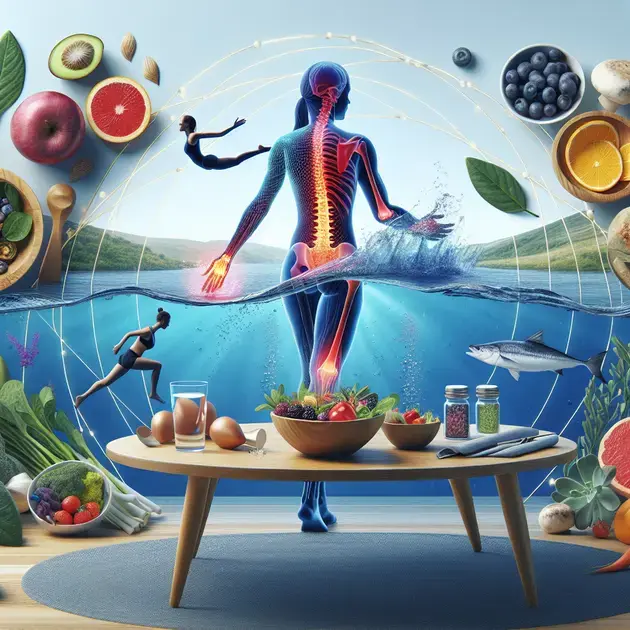Are you looking for a comprehensive guide on understanding and managing joint pain? Look no further, as this article provides an in-depth exploration of strategies to alleviate discomfort and improve quality of life. Joint pain can significantly impact daily activities and overall well-being, making it crucial to address effectively.
With the latest advancements in medical research and treatment options, individuals experiencing joint pain have an array of resources at their disposal. By understanding the root causes of joint pain and implementing targeted management techniques, individuals can take proactive steps towards a healthier and more comfortable lifestyle.
Understanding Joint Pain: Causes and Symptoms
Joint pain can be caused by a variety of factors, including injuries, arthritis, overuse, or underlying medical conditions. Injuries such as sprains, strains, or fractures can lead to acute joint pain, while chronic conditions like osteoarthritis or rheumatoid arthritis can result in persistent discomfort. Additionally, autoimmune diseases, infections, and metabolic disorders can also contribute to joint pain.
The symptoms of joint pain may vary depending on the underlying cause, but common signs include pain, swelling, stiffness, and reduced range of motion in the affected joint. In some cases, joint pain may be accompanied by redness, warmth, or tenderness around the joint. It is essential to consult a healthcare professional for an accurate diagnosis and appropriate treatment.
Steps to Identify Causes and Symptoms:
- Keep a symptom journal to track the frequency and intensity of joint pain episodes.
- Visit a healthcare provider for a thorough physical examination and diagnostic tests.
- Discuss your medical history, lifestyle factors, and any recent injuries that may be contributing to joint pain.
- Work with a healthcare team to develop a personalized treatment plan based on the identified causes and symptoms.
- Follow up regularly with healthcare providers to monitor progress and make adjustments to the treatment plan as needed.
Effective Strategies for Managing Joint Discomfort
Managing joint discomfort involves a combination of lifestyle modifications, therapeutic interventions, and self-care practices. Regular exercise, maintaining a healthy weight, and practicing good posture can help reduce joint strain and improve overall joint health. Additionally, dietary changes, such as incorporating anti-inflammatory foods and staying hydrated, can support joint function.
Physical therapy, occupational therapy, and assistive devices like braces or splints can also aid in managing joint discomfort and improving mobility. Over-the-counter pain relievers, topical creams, and joint supplements may provide temporary relief from pain and inflammation. In severe cases, surgical interventions may be recommended to address structural issues contributing to joint discomfort.
Strategies for Effective Joint Discomfort Management:
- Develop a tailored exercise routine with guidance from a physical therapist or fitness professional.
- Adopt a balanced and nutrient-rich diet to support joint health and reduce inflammation.
- Practice relaxation techniques, such as meditation or yoga, to manage stress and improve overall well-being.
- Explore alternative therapies like acupuncture or chiropractic care to alleviate joint pain and discomfort.
- Engage in open communication with healthcare providers to address any concerns or changes in joint symptoms.
Innovative Treatment Options for Joint Pain
Advancements in medical technology have led to innovative treatment options for joint pain that aim to provide targeted relief and improve joint function. Minimally invasive procedures, such as arthroscopy or joint injections, can help diagnose and treat joint issues with reduced recovery time. Regenerative medicine therapies, including platelet-rich plasma (PRP) injections or stem cell therapy, offer promising results in promoting tissue repair and reducing inflammation.
Biologic medications, such as tumor necrosis factor (TNF) inhibitors or interleukin-6 (IL-6) blockers, target specific pathways in the immune system to manage inflammatory joint conditions effectively. Surgical interventions like joint replacement surgery or arthroplasty may be recommended for severe cases of joint damage that do not respond to conservative treatments.
Innovative Treatment Options for Joint Pain:
- Explore regenerative medicine clinics like XYZ Regenerative Care for cutting-edge therapies to address joint pain.
- Consult with an orthopedic specialist at ABC Joint Center to discuss surgical options for long-term joint pain relief.
- Research clinical trials for novel medications or treatments targeting joint inflammation and degeneration.
- Stay informed about emerging technologies and treatment modalities in the field of orthopedics and joint care.
- Engage in shared decision-making with healthcare providers to determine the most suitable and effective treatment approach for managing joint pain.
Common Myths About Arthritis Pain
When it comes to arthritis pain, there are several common myths that can lead to misconceptions and misunderstandings. One such myth is that arthritis only affects the elderly. In reality, arthritis can impact people of all ages, including children. Another myth is that exercise will worsen arthritis pain. However, regular exercise can actually help improve joint function and reduce pain. Additionally, some believe that cracking your knuckles can cause arthritis, but there is no scientific evidence to support this claim.
To address these myths, it is important to educate oneself and others about the true nature of arthritis pain. By understanding the facts and dispelling these misconceptions, individuals can take proactive steps to manage their symptoms and improve their quality of life.
Here is a step-by-step guide on how to debunk common myths about arthritis pain:
Step 1: Educate Yourself
Research reputable sources to learn more about arthritis and how it affects the body. By arming yourself with accurate information, you can confidently correct any misconceptions you encounter.
Step 2: Share Knowledge
Spread awareness by sharing accurate information with friends, family, and colleagues. By educating others, you can help dispel myths and promote a better understanding of arthritis pain.
Step 3: Encourage Dialogue
Engage in open discussions about arthritis pain and its common myths. Encouraging dialogue can lead to greater awareness and acceptance of accurate information.
Step 4: Lead by Example
By living a healthy and active lifestyle despite arthritis pain, you can demonstrate that these myths are not true. Serving as a role model can inspire others to adopt positive habits and dispel misconceptions.
Holistic Approaches to Relieving Joint Stiffness
Joint stiffness is a common issue for many individuals, especially those with arthritis. While traditional treatments such as medication and physical therapy can be effective, holistic approaches can also play a significant role in relieving joint stiffness. These holistic practices focus on treating the whole person, addressing physical, mental, and emotional aspects of joint health.
One holistic approach to relieving joint stiffness is through mindfulness techniques, such as yoga and meditation. These practices can help improve flexibility, reduce stress, and enhance overall well-being. Another approach is acupuncture, which involves the insertion of thin needles into specific points on the body to alleviate pain and promote healing.
Here is a step-by-step guide on how to implement holistic approaches to relieving joint stiffness:
Step 1: Explore Holistic Therapies
Research different holistic therapies that have been shown to benefit joint health, such as yoga, acupuncture, and massage therapy. Consider consulting with a healthcare provider or holistic practitioner to determine which approaches may be most beneficial for you.
Step 2: Incorporate Mindfulness Practices
Integrate mindfulness practices like meditation and deep breathing exercises into your daily routine. These practices can help reduce stress, improve relaxation, and enhance overall joint mobility.
Step 3: Maintain a Healthy Lifestyle
Focus on establishing a balanced diet, regular exercise, and adequate sleep to support your joint health. By taking a holistic approach to your overall well-being, you can effectively manage joint stiffness and improve your quality of life.
Step 4: Consult with Professionals
Seek guidance from healthcare providers, holistic practitioners, or wellness experts to create a personalized holistic treatment plan for relieving joint stiffness. Collaborating with professionals can help you achieve optimal results and address your specific needs.
The Role of Nutrition in Joint Health
Nutrition plays a crucial role in supporting overall joint health and managing conditions like arthritis. A diet rich in anti-inflammatory foods, such as fatty fish, turmeric, and leafy greens, can help reduce joint pain and inflammation. On the other hand, a diet high in processed foods, sugars, and unhealthy fats can contribute to joint stiffness and discomfort.
It is important to understand how different nutrients impact joint health. For example, omega-3 fatty acids found in fish oil have been shown to have anti-inflammatory properties that can benefit individuals with arthritis. Additionally, vitamin D is essential for maintaining strong bones and healthy joints.
Here is a step-by-step guide on how to optimize nutrition for joint health:
Step 1: Adopt an Anti-Inflammatory Diet
Incorporate foods that are known for their anti-inflammatory properties, such as fruits, vegetables, nuts, and seeds. These foods can help reduce joint pain and swelling while promoting overall well-being.
Step 2: Supplement Wisely
Consider incorporating supplements like fish oil, turmeric, and glucosamine to support joint health. Consult with a healthcare provider to determine which supplements are right for you and ensure they complement your diet.
Step 3: Stay Hydrated
Drink plenty of water throughout the day to keep your joints lubricated and functioning properly. Proper hydration is essential for joint health and can help prevent stiffness and discomfort.
Step 4: Monitor Your Diet
Keep track of how different foods affect your joint pain and stiffness. By paying attention to your diet and making adjustments as needed, you can better manage your joint health and overall well-being.
Conclusion
In conclusion, debunking common myths about arthritis pain is crucial to promoting accurate understanding and proactive management of symptoms. By educating oneself and others, sharing knowledge, encouraging dialogue, and leading by example, individuals can dispel misconceptions and improve their quality of life. Taking holistic approaches to relieve joint stiffness, such as exploring different therapies, incorporating mindfulness practices, maintaining a healthy lifestyle, and consulting with professionals, can significantly enhance joint health and overall well-being.
Furthermore, optimizing nutrition for joint health by adopting an anti-inflammatory diet, supplementing wisely, staying hydrated, and monitoring one’s diet can play a vital role in reducing joint pain and inflammation. Understanding the impact of nutrients like omega-3 fatty acids and vitamin D on joint health is essential for individuals with arthritis to manage their condition effectively and maintain strong bones and healthy joints.
By following the step-by-step guides outlined in the post and integrating a combination of accurate information, holistic practices, and proper nutrition, individuals can empower themselves to take control of their joint health, alleviate pain and stiffness, and improve their overall quality of life.



















